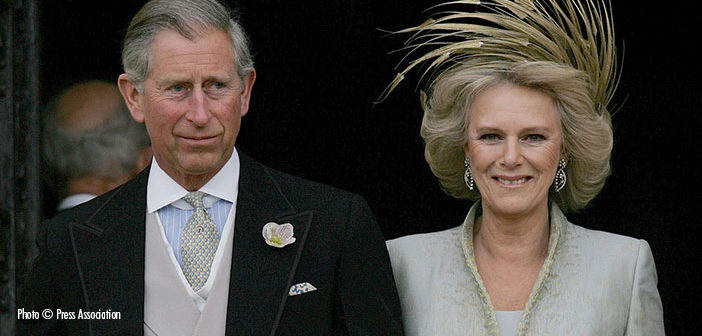Charles and Camilla’s new life together: The wedding of Prince Charles and Camilla Parker-Bowles took place on April 9, 2005, at Windsor Guildhall at 12.30pm. Charles and Camilla had spent the eve of the wedding apart. They met up the following morning at Windsor Castle and at 12.23pm they departed for the town centre in a chauffeur driven claret Phantom VI Rolls Royce, a present to HM The Queen during her Silver Jubilee in 1977. In Windsor crowds of around twenty-thousand had gathered along the route since dawn in anticipation of the service. The royal car passed through Windsor Great Park and the Long Walk before turning right through Cambridge Gate and into Park Street, where they were greeted by cheering crowds. They were shadowed by a second car in case of a breakdown. Members of the bride and groom’s families arrived at Windsor Guildhall in minibuses.
If their father betrayed a little nervousness, his sons looked relaxed. Harry was animated, William confident and smiling. There was a classic moment of wedding humour when William thought he had forgotten the ring. A look of horror briefly passed across his face, replaced by a beaming smile when the ring was located! For the wedding, Camilla chose to wear a cream-coloured suit complimented by a wide-brimmed cream-coloured hat. For the blessing afterward, she changed into a floor-length embroidered pale blue coat over a matching chiffon gown and a dramatic spray of golden feathers in her hair. Both ensembles were the creation of London designers Antonia Robinson and Anna Valentine. Camilla’s hats were the work of Irish milliner Philip Treacy. In traditional fashion, the couple’s wedding rings were made from 22 carat Welsh gold from the Clogau St David’s mine in Bontddu. They were designed by Wartski, a London jeweller that has held the Royal Warrant to The Prince of Wales since 1979.
The Parker-Bowles’ family was headed by Camilla’s father, Major Bruce Shand, who cut a dignified and surprisingly sprightly figure; while Sara Buys, fiancée of Tom Parker Bowles, cut a dash in a daring dress. The Royal Family was well represented, although two notable and much commented upon absentees at the civil service were HM The Queen and The Duke of Edinburgh. At 12.30pm the civil ceremony was performed by 45 year-old mother of two, Clair Williams, in the Ascot Room of the seventeenth century Guildhall. The witnesses were Prince William and Tom Parker Bowles. Television cameras were barred. After the ceremony the couple returned to Windsor Castle.
The wedding legalities having been completed, the afternoon was set aside for a service of prayer and dedication. The couple entered St. George’s Chapel through the Galilee Porch at 2.30pm. Unlike the wedding, the blessing was televised. The service was led by the Archbishop of Canterbury, Dr Rowan Williams, and was attended by the Queen and Prince Philip, along with royals from Europe and The Commonwealth. At 2.37pm the Prince and the Duchess of Cornwall, along with the congregation, recited an acknowledgement of past “sins and wickedness” taken from the 1662 Book of Common Prayer. Some commentators misconstrued the moment, suggesting that the recitation was unusual; but the confession is regularly recited during Anglican and Episcopalian church services around the world. To conclude the blessing, Archbishop Williams led the congregation in the recitation of the Niceno-Constantinopolitan Creed. At 3.12pm the couple left the cathedral via the West Door, where they were joined by the Queen, members of the Royal Family, the Archbishop of Canterbury and the newly titled Duchess of Cornwall’s relatives. Outside the chapel, Charles and Camilla paused to greet well-wishers, then were driven to the state apartments for a reception given by the Queen.
It had been as much an English country wedding as a royal one, with all the charm and particularity that brings with it. The mood was relaxed and rather jolly. The Queen’s speech at the reception caught the good natured atmosphere: “I have two very important announcements to make. I know you will want to know who was the winner of the Grand National. It was Hedgehunter.” Then, as wry reference to the day’s other noteworthy event, she added, “Having cleared Becher’s Brook and the Chair, the happy couple are now in the winner’s enclosure.” It was fair comment. The day had gone smoothly, despite the odd awkward moment caused by protesters along the wedding route calling for Charles to renounce his right to the throne.Those who objected to the wedding have not as yet been convinced that Charles has done the right thing. It has certainly been a struggle, which will seem extraordinary in future years, but the widowed Prince has, ultimately, simply married for a second time.
Nonetheless, without wishing at all to rain on Charles and Camilla’s parade, the memories of the past had dogged every step they took on their way to the altar. Lord Melvyn Bragg, writing in The Sunday Times, summed up what the day symbolised: “Clearly we witnessed, and everybody who tuned in on television or radio, witnessed, the end of a chapter. It’s been turbulent, it’s been tragic and it’s been in every private and public way awful. But this was the end of that chapter. Above all, what the ceremony did was to turn the page to a new beginning.” Most would agree that the day had been a considerable success, one that vindicates Charles’ determination to finally marry his lifelong love. The future for Charles and Camilla is, at last, an open book upon which they hope to write a new chapter of personal happiness and public service.




